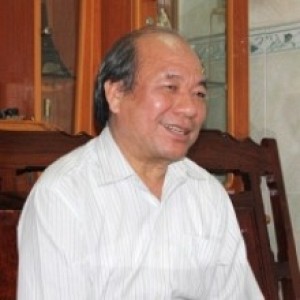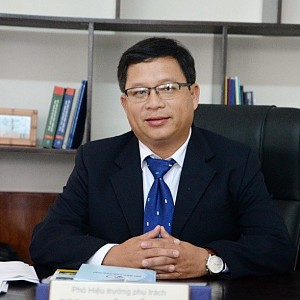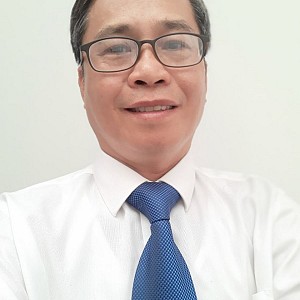Search Papers
48 papers
Heavy metals are the most dangerous substances in the environment, have caused deleterious effect not only to the environment but also to the public’s health. Different studies have demonstrated that plants have a high removal capacity for lead ions from pollution sources. However, these plant species were rather limited. Thus, the project aimed to find out plant species that represent its lead removal ability to reduce environmental pollution. The experiment was carried out factorially as a randomized complete design in hydroponic systems with four treatments (0, 100, 200, and 300 mg/l of Pb) and three replications. The results indicated that the growth of the Dracaena sanderiana plant is well in Pb concentration of 100 mg/l, with less growth while the increasing lead concentration of 200 mg/l and 300 mg/l. The amount of lead in the water of three treatments 100 mg/l, 200 mg/l, and 300 mg/l after 30 days of the experiment decreased by 91.5%, 86.8%, and 86.4%, respectively. It was found that Dracaena sanderiana exhibited high lead treatment efficiency in the water. Moreover, results showed that the accumulation of lead in the roots of Dracaena sanderiana is quite large with treatments of 100 mg/l, 200 mg/l, and 300 mg/l lead concentrations were 5073.8 mg/kg, 5134.0 mg/kg, 7054.0 mg/kg, respectively. In contrast, the ability to lead accumulation in plant leaves and stems is lower. cultivated in hydroponic systems with four treatments and three replications. Four levels of Pb(NO3)2 (0, 100, 200, and 300 ppm) were used. The monitoring indicators include the contents of lead in water, the growth target of Dracaena sanderiana, and the accumulation of lead contents in different organs of Dracaena sanderiana. The results indicated that: the growth of the Dracaena sanderiana plant is well in Pb concentration of 100 ppm, with less growth while the increasing lead concentration of 200 ppm and 300 ppm. The amount of lead in the water of three treatments 100 ppm, 200 ppm, and 300 ppm after 30 days of the experiment decreased by 91.5%, 86.8%, and 86.4%, respectively. It was found that Dracaena sanderiana exhibited high lead treatment efficiency in the water. Moreover, results show that the accumulation of lead in the roots of Dracaena sanderiana is quite large with treatments of 100 ppm, 200 ppm, and 300 ppm lead concentrations were 5073.8 mg/kg, 5134.0 mg/kg, 7054.0 mg/kg, respectively. In contrast, the ability to lead accumulation in plant leaves and stems is much lower.
Through analysis of the DPSIR model, combined with research methods such as field surveys, and survey questionnaires, the author has given the following results: The amount of waste is increasing; Not paying attention to the classification at source, Solid waste collection is still limited; Environmental quality is degraded due to the stench caused by domestic waste in some neighborhoods; The soil environment is polluted due to solid waste treatment that is difficult to decompose; Surface water and groundwater are also leaked due to leachate, wastewater from landfills; The polluted environment has, directly and indirectly, affected the health and production and business activities of the people in the ward, degraded the ecosystem, and lost the urban beauty. The author has proposed solutions to reduce environmental pollution caused by domestic waste such as population policy, establishing collection groups, craft village planning, and applying the circular green model in economic development.
Over the past few years, there are many activities had negative impacts on the surface water of the Dong Nai river such as industry, agriculture, and service development activities; therefore river water quality is significantly relieved. This study was conducted to evaluate the effect of elements on the water quality in 2022 through analyze the parameters of pH, temperature, DO, BOD5, COD, N-NH4+, P-PO43-, TSS, turbidity, total Coliform on 54 samples, compared with QCVN 2015 for river water quality and the water quality index calculation WQI. The analysis results show that the water quality of Dong Nai river, sections flowing through Bien Hoa city from Jan to Dec is not quite good, most parameters reach the limit value B1 according to QCVN 08:2015/BTNMT; however, the values of parameters DO, total coliforms, TSS exceed the limit value B1 significantly. WQI values fluctuate at a fairly high level from 17 to 68, and the average WQI of the river reaches is quite low, so the authority should have promulgated the law to protect the water surface of this river; therefore water quality assessment is significant for better control and management of the surface water environment in Vietnam.
Assessment of air quality and community health risks in Di An city - Binh Duong province
Tran Thi Khanh Hoa, Bui Pham Phuong Thanh, Nguyen Thị Thanh Thao, Tran Thanh Liem
Based on research methods such as methods such as data collection and processing, air quality index calculation methods, public health risk assessment methods to assess air quality and effects of substances on the health of people in Di An city. The data for the calculation are inherited from the environmental monitoring report of the Department of Natural Resources and Environment of Di An city in the period of 2019. The calculation results show that the air quality in the city. Di An is fluctuating at an average - poor level (especially in the Cay Lon junction area with the highest index of 150), the health risk assessment results show that when exposed to dust, the total group of people Adults (Women and Men) had a high fluctuating cancer risk index with the highest index of 2 subjects being in the first quarter 0.310, 0.295, in the second quarter 0.269, 0.282, in the third quarter 0.296, 0.282, Fourth quarter 0.289, 0.275. As for other indicators, the subjects assessed when exposed to substances in the air environment in Di An city can be affected to their health, of which the group of adults is still the group of people. Women and men) are the most affected group.
Application of TOPSIS and AHP methods to select a wastewater treatment technology for Poong In Vina Factory
Dang Tuan Hai, Nguyen Hien Than, Nguyen Huynh Anh Tuyet
Selecting wastewater treatment technology is not an easy matter. In this study, TOPSIS and AHP methods are used to support decision-making in choosing a wastewater treatment alternative for Poong In Vina factory. A total of 9 criteria belonging to 3 groups of economic, social - technical and environmental issues were used to select an alternative. The results of TOPSIS and AHP analysis showed that aerobic biotechnology integrated with membrane bioreactor technology is the optimal solution. The outcomes of this study will help the company in choosing the best option among these technologies. Furthermore, it will provide an insight for relevant stakeholders such as engineers, manufacturers and other ogranizations for making decisions.
Research for building the smart university model at Thu Dau Mot University
Trinh Quoc Thanh, Vo Gia Thinh
In recent years, society has been evolving rapidly, and contemporary education is being adapted to satisfy people's requirements in accordance with 4.0 trends and the industrial revolution.This gives birth to the definition of Smart University, the study of which seeks to identify the required components for constructing a smart learning environment. The research group analysed nationally and internationally advanced models, proposing a smart university model for Thu Dau Mot University (T-SMARTHS) with smart levels matching the phases established and developed at Thu Dau Mot University.
Application Of Iso 14001:2015 International Standards In Determination Of Environmental Aspects At Market Pig Farm With Semiautomatic Technology Farm Size 12,000 Pigs Per Year In Phu Giao District, Binh Duong Province
Nguyen Thị Xuan Hanh, Vo Thi Hong Tham, Vo Thi Hai Yen
Recognized as a smart city, Binh Duong's smart city development strategy also includes the development of automated agriculture, typically large-scale livestock farming. A sustainable urban development will not be able to ignore the factor of providing food for urban and regional people. Phu Giao district - Binh Duong province is one of the leading districts in livestock farming, especially concentrated pig farming. The agricultural industry, pigs breeding, is one of the strengths of the district, besides the cultivation of short and long-term industrial crops such as rubber, cashew, Ho Tieu... Livestock is a very old profession of the Vietnamese people in Phu Giao district as well as in Binh Duong province. The contribution of livestock production to the socio-economic face of the district cannot be denied. However, animal husbandry activities, besides the economic values, also cause some consequences to the natural environment such as soil and water pollution, noise, odors in the air, etc. Hence, we decided to do the research of "Application of ISO 14001:2015 international standards in determination of environmental aspects at market hog farm with semiautomatic technology farm size 12,000 pigs per year in Phu Giao district, Binh Duong province" (TCVN ISO, 2015). This is a large-scale pig farm with modern semi-automatic technology equipment. We expect to find out environmental issues in the most detailed and specific way so that the owner can overcome the above environmental problems, rest assured to raise livestock and develop more expansion later. We conducted a review of the areas on the farm, evaluated the activities in each area, from which we found out the environmental problems through the material flow diagram (Phạm Thị Hồng Cẩm, 2020). Next, through the multi-criteria method (Phạm Thị Hồng Cẩm, 2020) we calculated the score and found the most significant environmental aspects (most environmental risk). The research results will be a general picture to provide farm owners with an intuitive and easy-to-understand view for suitable solutions. Developing farm economy along with environmental protection towards sustainable development of livestock agriculture.
The Demonstration Device For Remote Light Control Via The Internet By Using MQTT Protocol And Dual-Chip ESP32
Vo Gia Thinh
In this article, the primary purpose is to design and implement a remote light control example that makes use of the Arduino IDE platform for programming, the MQTT protocol, and an ESP32 microcontroller, which has a dual-core CPU as well as Wi-Fi and Bluetooth capabilities. This aspect is related to the Internet of Things (IoT), which allows any fundamental device to be linked and become a smart device via the application of the Internet. As a result, these devices can be operated from a significantly long-distance, eliminating the need to physically interact with the switches to turn them on or off. The first part of the paper is a discussion of the fundamental theory that is provided to examine the potential of remote control methods, followed by a short overview of the Arduino integrated development environment (IDE), MQTT communication protocol, and PWM technique to regulate the brightness of lights. The second section is devoted to hands-on work, such as setting up an environment connection over the Internet, compiling and designing a printed circuit board (PCB).
This article is the results of the project "Assessment of health and safety risks for wood industry workers researched at Lap Giai company, Ben Cat district, Binh Duong province". Theory of change (ToC) is an intervention strategy to reduce worker health risk and safety that was initially established by the research team before being deployed at Lap Giai Company.
Preparation ToC helps promote and cooperate in the co-production of knowledge between the academic and management group. The paper is a summary of 10 steps of the ToC method, in which, planning, analyzing change needs, projecting impacts, mapping intermediate results, determining project outputs, identifying assumptions, creating diagrams and explaining the ToC are important steps.
The experiences drawn from the theory of change in transdisciplinary study are (1) Can be applied to digital transformation research and environmental management research in enterprises. (2) Role leadership is decisive in developing transdisciplinary topics in enterprises. (3) Both internal and external environments must be considered to design the most beneficial change interventions.
The blended learning: English majors’ perception of its effects on their writing skills
Huỳnh Thị Bích Phượng
ABSTRACT
With the ever-increasing development of technology, online teaching is more readily accepted as a viable component in teaching and learning, and blended learning, the combining of online and face-to-face learning, is becoming commonplace in many higher education institutions. Definitely, challenges cannot be denied; however, it has been suggested and deployed globally including Vietnam. To some extent, both teachers and students present their positive points of view on this learning approach. However, there are a huge number of students expressing their lack of understanding the blended learning, which negatively affects their attitudes towards deployment of this learning approach as well as particular reference to motivation and interest. This paper is to assess the English majors’ perceptions on blended learning environment at tertiary level, which especially affects their learning the writing skills.
Results of the study are absolutely helpful for the author to understand the students’ perceptions of the effects on the blended learning; then, she can give some suggestions to enhance the learning of writing skills in the light of blended learning.
Key word: Blended learning, academic writing, perception
Analysing Energy and Environmental Performance of a Residential Grid-Connected Photovoltaic System in Thu Dau Mot City, Vietnam
Nguyen Ba Thanh, Nguyen Phuong Tra
The electricity obtained from the photovoltaic (PV) system highly depends on various factors such as geographical location, solar radiation, weather conditions and orientation of solar panels. The electricity produced by the solar PV system can be assessed by using simulations. This paper presents a technical feasibility assessment of a 10 kWp rooftop solar PV system for a household in Thu Dau Mot City, Vietnam. The study presents the amount of electricity produced, the performance of the PV system and the system potential to reduce CO2 emissions into the environment. The designing and evaluating of the system performance is done by PV*SOL, PVsyst and PVGIS software. The project provides useful information for the pre-feasibility assessment phase of a residential solar PV project in Vietnam.
In Vietnam, deviant behaviour in adolescents is increasingly popular and gradually becomes a major concern of the whole society. The purpose of this study is to identify Factors affecting deviant behavior of Vietnamese adolescents, including: Nature of adolescence (Biology, Intelligence and Cognitive functions) and Nurture (Family atmosphere, Education environment, Media and technology, Peer Pressure, and Religion and Politics). 426 survey samples were collected to serve the data analysis process as well as all hypotheses were examined by using STATISTIC 10 ver., LISREL 8.8 with Covariance Matrix, and LISREL model. This research showed that Nature of adolescence, Family atmosphere, Education environment, Social media and technology, Peer pressure have significant influence on deviant behavior of adolescents in Vietnam. The research also indicated that deviant behavior of Vietnamese adolescents is not affected by Religion and politics. The study also makes suggestions to improve morality and foster personality for adolescents in Vietnam, makes a small contribution to the country's further development.
Spent Coffee Grounds Collected in Ho Chi Minh City: A Good Source of Phenolic Acids and Fatty Acids
Vũ Công Danh, Vũ Thị Quyền , Nguyễn Hà Diệu Trang
Coffee is among the favorite drinks in Vietnam and many other countries. Production and consumption of coffee have released a huge amount of spent coffee ground. This study aimed to determine phenolic acids and fatty acids of spent coffee grounds collected in Ho Chi Minh city and how phenolic acid profile was affected by different environmentally friendly extractants. The results showed that average level of chlorogenic acid in ethanol/water extracts (840.4 779.9 ug/g) was significantly higher compared to water extracts (300.0 ug/g). Furthermore, the average total level of phenolic acids in ethanol/water extracts (1215.3 ug/g dry weight) was greater than that in the water extracts (779.9 ug/g dry weight). This indicated that ethanol/water outperformed water in regard to extraction of phenolic acids in the spent coffee grounds. Oil extracted from the spent coffee grounds was rich in linoleic acid (61 ug/g) and palmitic acid (47 ug/g). The findings of our study showed that the spent coffee grounds originating in Vietnam are a good source of phenolic acids and polyunsaturated fatty acids that could be utilized for food and nutraceutical production.
Heavy metal pollution is a major problems in the environment. The impact of toxic metal ions can be minimized by different technologies, viz., chemical precipitation, membrane filtration, oxidation, reverse osmosis, flotation and adsorption. But among them, adsorption was found to be very efficient and common due to the low concentration of metal uptake and economically feasible properties. In this review paper, Fe–Mn binary oxide incorporated into diatomite (Fe/Mn-diatomite) was prepared by a simple coating method , and removal of Cu(II) from aqueous solutions. The effects of three independent variables including initial ion concentration, removal time, and adsorbent dosage were investigated on the maximum adsorption of Cu (II). The optimum conditions for the adsorption of Cu(II) was obtained: 75 ppm of initial ion concentration, 150 min of removal time and 1.5 g/l of adsorbent. The maximum removal efficiencies of Cu(II) was obtained 86.25%. The results showed that Fe/Mn-diatomite was apable of treating copper metal in wastewater.
An review on bioethanol production using lignocellulosic biomass
Trương Nguyễn Phương Vi
Declining supplies of fossil fuels, increasing population, global industrialization and demand for transportation fuels has triggered an increase in the demand for renewable energy sources. To address such problems most of the green research in the recent years has focused on the development of bioethanol (23 MJ/L) as a substitute to conventional gasoline (34.3 MJ/L) based fuels owing to the similarity in energy density values in addition to several other advantages (American Council on renewable energy, 2010). Second-generation biofuels are derived from lignocellulosic biomass or woody crops, mostly coming from agricultural residues. Extraction of fuel from such biomass is difficult because of their recalcitrant nature (corn stover, rice straw, wheat straw, sugar cane and sweet sorghum). Lignocellulosic fuel has the potential to solve several problems (food competing with fuel) that are currently associated with first generation biofuels. Moreover, lignocellulosic fuels can supply a larger proportion of the global fuel leading to sustainability at lower cost, and with greater environmental benefits (Liz Marsall, 2009). The production of ethanol from the complex sugars in leaves and stalks is a promising strategy to radically broaden the range of possible ethanol feedstock.
Keywords: lignocellulose, bioethanol, biomass, pretreatment, hydrolysis, fermentation.
Assessment of environmental risk from polluted organic wastewater in Long Thanh Industrial Park with the Nemerow index and Principal component Analysis
Nguyen Hien Than
This study aims to assess environmental risk using the improved Nemerow index and the principal component analysis (PCA) method in Long Thanh's Industrial Park in Dong Nai Province. The study was implemented in five industrial parks of Long Thanh District in 2019. The result showed that Loc An - Binh Son industrial park was at extreme high risk of the level (6.7). Three industrial parks of Long Thanh, Go Dau and An Phuoc were high-risk (from 3 to 5) respectively. On the other hand, Long Duc Industrial Park has obtained no environmental risk.
Hazard Identification and Risk Assessment in Wastewater Treatment Plant of Di An City
Ho Tong Tron, Nguyen Hien Than
The wastewater treatment plant is an extremely important infrastructure to ensure the quality of life, water use of human life, and other ways to ensure water quality for the natural environment. In the operation of it, there are always potential hazards affecting the health of the workers working in the factory. The study was performed using the Semi-quantitative risk assessment method to calculate the values of operational risks in the water treatment plant (WWP). The results of the study obtained 18 high potential hazards that may lead to the present in the water treatment process. The hazards were the leakage of deodorizing towers and the generation of toxic emissions of dead microorganisms that have the highest value with a risk scale of 20 points- frequent impacts on employees. The study has also identified the dangers present in WWP and this will be the premise for mitigating solutions for problems occurring at its.
Environmental issues such as the wastewater have influenced each aspect of our lives. For human and environmental health protection, it is necessary to remove excess zinc in industrial wastewaters before discharging them to environment. Modified diatomite displayed larger surface area and pore volumes in comparison with untreated natural diatomite, which favored heavy metals sorption behavior. In this study, the removal of Zn(II) ions from aqueous solution was studied using Fe/Mn modified diatomite sample at different adsorption parameters such as contact initial metal ions concentration, dosage of Fe/Mn-Diatomite and ionic strength Na2CO3 on ionic Zn2+ adsorption capacity of diatomite modified. The residual zinc concentration in the solution was determined using flame atomic absorption spectroscopy. The results showed that: the gravitational increase increases with increasing time and then becomes almost stable, with 120 minutes timeliness; absorption increases when Fe/Mn-Ditomite is increased, absorption reaches 89.48% at a dose of 1.5 g/l; additional different concentrations Na2CO3 ranged from 0 ppm to 80 ppm the results showed that performance treatment Zn2+ of correspond 94,85%.
This study could lay an essential foundation to develop modified diatomite for heavy metal removal from wastewater.
Environmental Risk Assessment of Organic Pollution on Wastewater on Industrial Parks in Bien Hoa City
Tran Cong Hau, Nguyen Hien Than
Bien Hoa City is an urban area of Dong Nai province located in the Southern key economic region. Currently, Bien Hoa City has 6 industrial parks in operation with large daily wastewater flow, causing environmental risks, especially from organic pollutants. The study applied the Nemerow risk index and the geographic information systems (GIS). The results showed that the industrial parks were mainly organic pollution levels including N-total, P-total, and Ammonium. The level of environmental risk from organic pollution was recorded in range of medium to very high levels, the ranked in descending order: Agtex Long Binh Industrial Park (P = 24)> Amata Industrial Park (P = 16)> Bien Hoa 2 Industrial Park ( P = 10),> Tam Phuoc Industrial Park (P = 5)> Loteco Industrial Park (P = 3). The results of the study provided good information for the management and improvement of wastewater quality in the industrial wastewater treatment plants of the industrial parks in Bien Hoa City.
Research factors impact on customer satisfaction in Vietnam restaurants
Le Huu Khanh, Trieu Thi My Hanh
Along with changes in Economy, Tourism and the influence of foreign waves, the market of Food Service in Vietnam has also changed to meet the needs of customers. At many restaurants in Vietnam, customer satisfaction can greatly affect restaurant revenue. Therefore, it is essential to determine which perceived quality factors affect customer satisfaction. The survey was conducted through questionnaires collected from 329 respondents, who experienced in restaurant services in Vietnam. In this paper, four factors are found that have influence on customer satisfaction in restaurants: Service quality, Product quality, Environment and Price. In addition, the research also gives some contributions based on the research results, helping businesses understand customers and meet customer satisfaction requirements in the restaurant.
Pattern Discovering for Ontology Based Activity Recognition in Multi-resident Homes
Nguyen Duy, Son Nguyen
Activity recognition is one of the preliminary steps in designing and implementing assistive services in smart homes. Such services help identify abnormality or automate events generated while occupants do as well as intend to do their desired Activities of Daily Living (ADLs) inside a smart home environment. However, most existing systems are applied for single-resident homes. Multiple people living together create additional complexity in modeling numbers of overlapping and concurrent activities. In this paper, we introduce a hybrid mechanism between ontology-based and unsupervised machine learning strategies in creating activity models used for activity recognition in the context of multi-resident homes. Comparing to related data-driven approaches, the proposed technique is technically and practically scalable to real-world scenarios due to fast training time and easy implementation. An average activity recognition rate of 95.83% on CASAS Spring dataset was achieved and the average recognition run time per operation was measured as 12.86 mili-seconds.
Study on design and fabrication of a prototype equipment used for corrosion inspection on petrochemical tank bottom by magnetic flux leakage method
Dang Quoc Trieu, Vuong Duc Phung, Bui Trong Duy, Tran Minh Tien, Lai Viet Hai, Tran Trong Hieu
Corrosion of the bottom of the petroleum tank may lead to a product leak that could cause a fire or explosion resulting in damage to people and the environment, therefore the test of tank bottom corrosion is necessary to be conducted periodically to prevent the occurrence of the above problems. In non-destructive inspection, the Magnetic Flux Leakage (MFL) method relies on the variation of fluxes caused by defects on the surface of materials to detect corrosion, pitting, or imperfections, which is proved quite effectively with low cost. The project was implemented to develop a prototype of the MFL bottom detection device based on the research results in the world to improve corrosion survey capacity in industrial equipment, as well as to improve the expertise in the Research Team of electronics and automation in the fields of magnetic fields and sensors. As a result, an MFL model using permanent magnets and Hall sensors were fabricated. Survey experiments showed that the machine could detect corrosion defects up to 20% of steel wall thickness in the scanning speed range from 500 mm/s to 1130 mm/s. However, to meet the actual survey needs, the team must continue to improve the device in terms of sensitivity, scanning speed, the ability to operate automatically or semi-automatically, and register for a fire safety inspection.
Building the environmental performance index for industrial parks
Phong Tran, Thuy Nguyen Thi Thanh, Pham Quoc Khanh, Than Nguyen Hien
Measuring environmental protection activities is a matter of great concern over the years. In this study, the indicators for evaluating environmental protection activities in industrial parks was built according to the PDSIR model and based on Vietnam's legal framework, including 18 main subjects and 35 indicators. The environmental performance index of industrial park (EPIIP) was established based on the multi-criteria evaluation method and the analytic hierarchy process method. The results of the study indicated that the VSIP I industrial park reached 68.95 points (relatively good level). Moreover, the results also showed that VSIP I was one of the industrial parks practicing good performance to protect environmental problems.
Evaluate the efficiency of the Environmental Management System Iso 14001:2015 at The Vietnam Onamba Company
Nguyễn Thị Xuân Hạnh, Do Thi Kim Ty
Nowadays, the benefits of ISO 14001:2015 abound, for minimizing environmental footprints, providing operational improvements, bringing lucrative business and improving the company’s image. There is an annual audit to decide if the company’s environmental management system meets the requirements of ISO 14001:2015. This is a significant audit that strongly affects the current certificate. The study to “Evaluate the efficiency of the environmental management system ISO 14001:2015 at the Vietnam Onamba Company” has been conducted to research the internal audit and examine any discordance in the environmental management system. The study carries out the internal audit of the environmental management system ISO 14001:2015 at VTO company by 3P method (P1: Paper check, P2: People interview, P3: Practice Observe). The result of the study showed a minor discordance at (6.2) Environmental Objectives and planning to achieve them. Regarding other clauses, they meet the requirements of the environmental management system. The result shows that the responsibility and careful observation of the company in controlling the system. The study evaluates reducing consumption (electricity, water, and chemicals) through collecting and comparing the data between 2017 and 2018. The results show the efficiency of reducing consumption: monthly electricity consumption reduced 21,86% (377 MWh); monthly water usage reduced 17,89% (1421 m3 ); annual chemical usage reduced from 3 to 6%.
Publication Information
Publisher
Thu Dau Mot University, Viet Nam
Honorary Editor-in-Chief and Chairman of the Editorial Board

Assoc. Prof. Nguyen Van Hiep
Deputy Editor-in-Chief

PhD. Trần Hạnh Minh Phương
Thu Dau Mot University
Thu Dau Mot University
Editorial Board

Prof. Tran Van Doan
Fujen University, Taiwan
Fujen University, Taiwan

Prof. Zafar Uddin Ahmed
Vietnam National University Ho Chi Minh City
Vietnam National University Ho Chi Minh City

Prof.Dr. Phillip G.Cerny
The University of Manchester, United Kingdom
The University of Manchester, United Kingdom

Prof. Ngo Van Le
University of Social Sciences and Humanities (VNU-HCM)
University of Social Sciences and Humanities (VNU-HCM)

Prof. Bui The Cuong
Southern Institute of Social Sciences
Southern Institute of Social Sciences

Prof. Le Quang Tri
Can Tho University
Can Tho University

Assoc. Prof. Nguyen Van Duc
Animal Husbandry Association of Vietnam
Animal Husbandry Association of Vietnam

Assoc. Prof. Ted Yuchung Liu
National Pingtung University, Taiwan
National Pingtung University, Taiwan

PhD. Anita Doraisami
Economics Monash University, Australia
Economics Monash University, Australia

Prof. Dr. Andrew Seddon
Asia Pacific University of Technology & innovation (APU)
Asia Pacific University of Technology & innovation (APU)

Assoc. Prof. Le Tuan Anh
Thu Dau Mot University
Thu Dau Mot University

Prof. Abtar Darshan Singh
Asia Pacific University, Malaysia
Asia Pacific University, Malaysia

Prof.Dr. Ron W.Edwards
The University of Melbourne, Australia
The University of Melbourne, Australia

Assoc. Prof. Hoang Xuan Nien
Thu Dau Mot University
Thu Dau Mot University

PhD. Nguyen Duc Nghia
Vietnam National University Ho Chi Minh City
Vietnam National University Ho Chi Minh City

PhD. Bao Dat
Monash University (Australia)
Monash University (Australia)

PhD. Raqib Chowdhury
Monash University (Australia)
Monash University (Australia)

PhD. Nguyen Hoang Tuan
Thu Dau Mot University
Thu Dau Mot University

PhD. Nguyen Thi Lien Thuong
Thu Dau Mot University
Thu Dau Mot University
Assistant

Nguyen Thi Man
Thu Dau Mot University
Thu Dau Mot University

